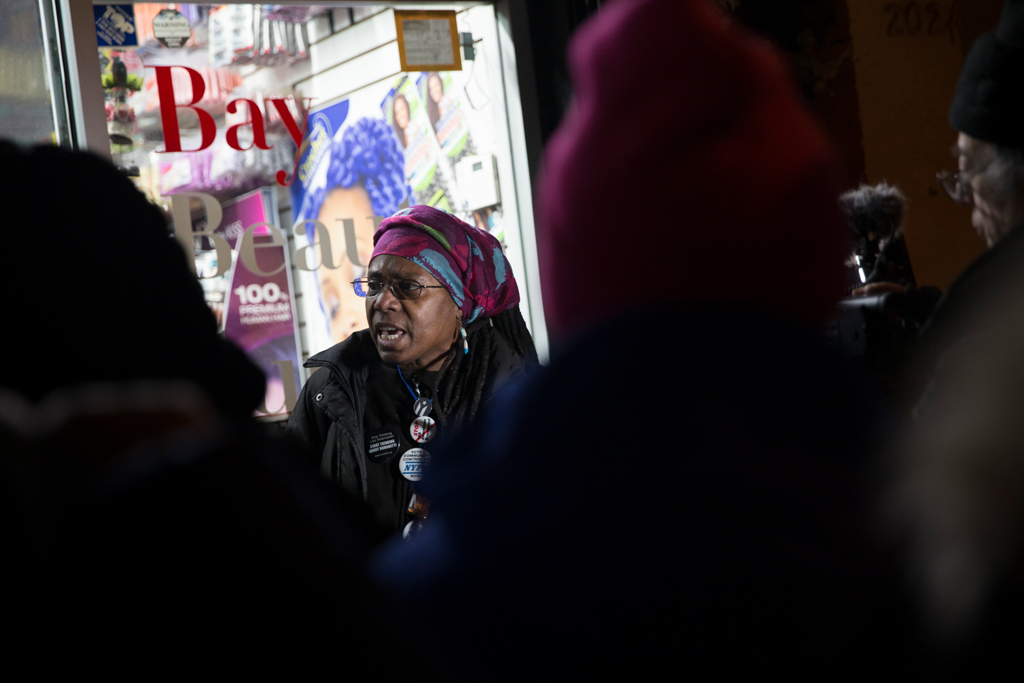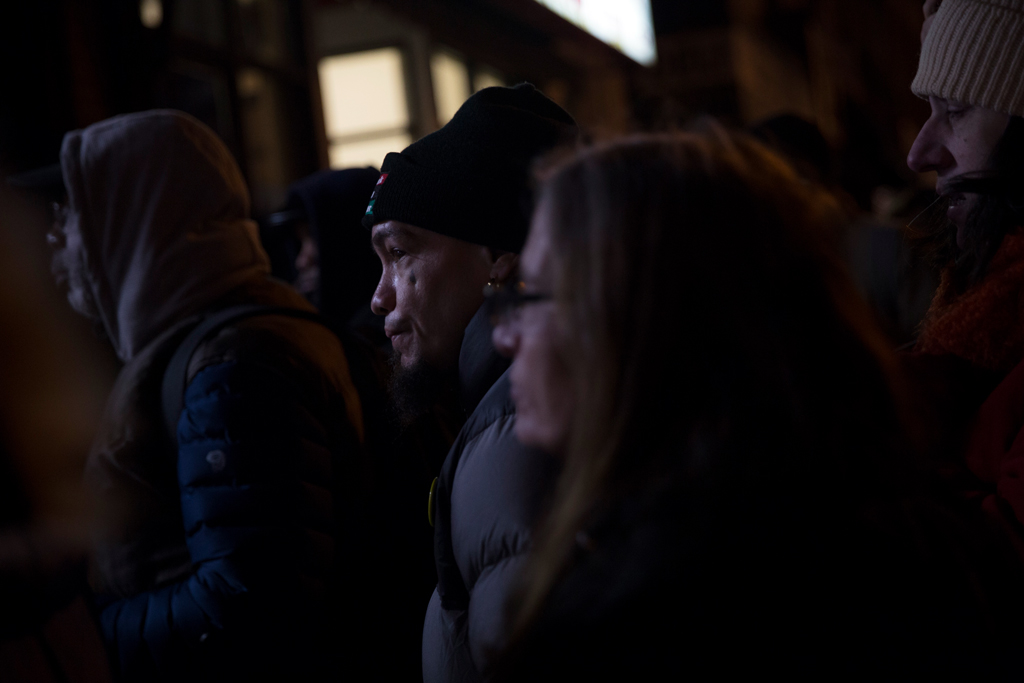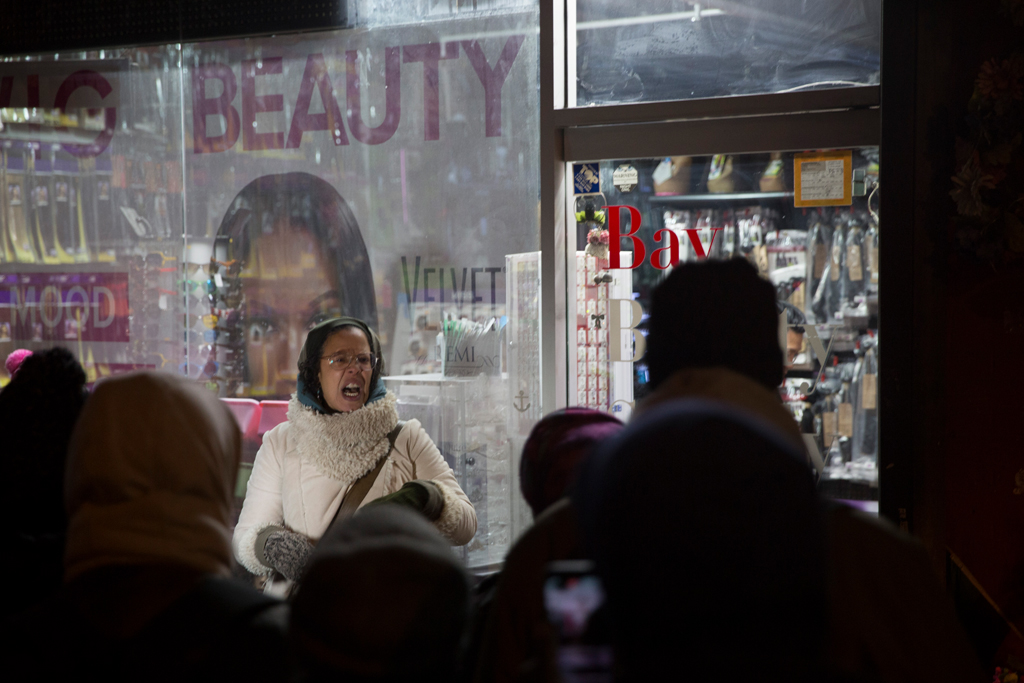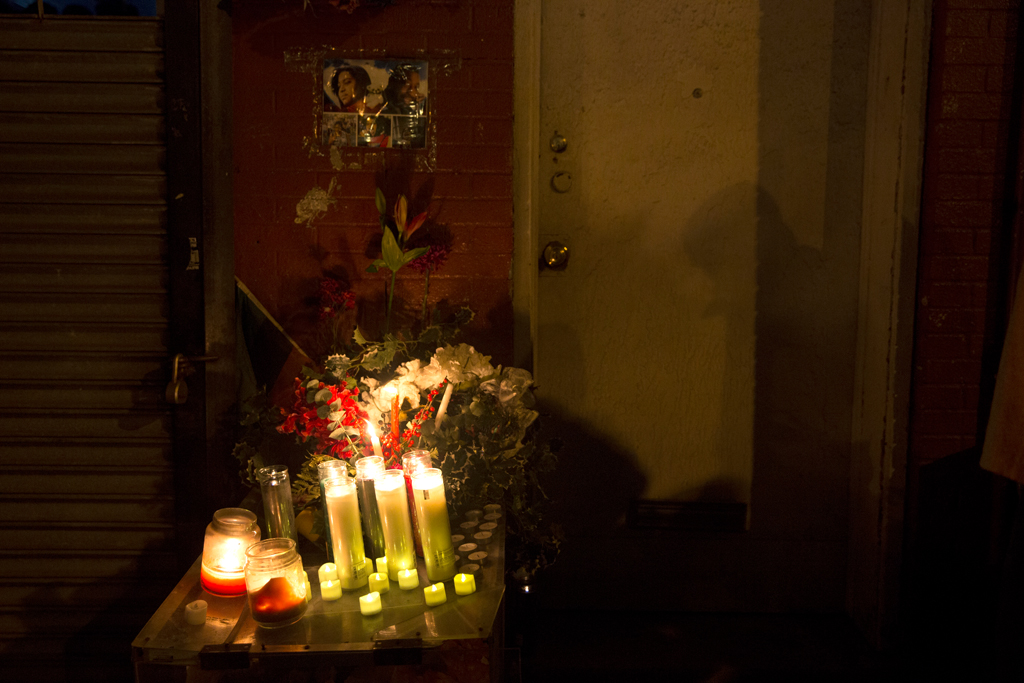STATEN ISLAND, New York — There are three pictures of Erica Garner; they are fixed to the chipped red brick wall with packing tape, just below a WigZone4Ever sign and just above the sagging and smudged plexiglass box covered in candles and filled with fake flowers and stuffed animals.
In one picture, she is leading a march against police brutality down the middle of a Staten Island street. In another she holds her hand outstretched over her head at a protest outside the 120th Precinct, the same precinct where Daniel Pantaleo, the officer who used an illegal chokehold to kill her father, was assigned. In another her mouth is wide open as she shouts into a megaphone, exhorting a crowd to fight at a rally.
The pictures are part of a small collage taped to the front of Bay Beauty Supply, the store where Eric Garner gasped, “I can’t breathe,” as he was being choked to death during an attempted arrest for illegally selling cigarettes.
Normally, Erica Garner would have been leading a vigil like this, encouraging people to fight to reform what she saw as a racist police system. But this was in her honor. Erica died on Dec. 30 after suffering an asthma-induced heart attack on Christmas Eve.
Erica Garner had recently talked about the physical, emotional and psychological toll her activism had taken on her since her father’s death in an interview with Benjamin Dixon, the host of a YouTube show.

Sister Shirley spoke to the crowd at the vigil for activist Erica Garner at the memorial for her father, Eric Garner, on Bay Street in Staten Island.
“I’m struggling right now with the stress and everything,” she said. “This thing, it beats you down. The system beats you down to where you can’t win.”
On Wednesday evening, friends, fellow activists and protesters looking for Erica’s leadership could only turn to the pictures taped to the wall. There were about 100 people in the multiracial crowd.
Although the vigil was intended to be a solemn remembrance, it was marked by discord. Some activists harangued others for only showing up when Erica died, not being by her side when she was working at the street level to organize protests and affect change somewhere other than a ballot box.
One activist who began chastising some of the attendees was drowned out by some in the crowd.
Anthony Beckford, the head of Brooklyn’s CopWatch and an ally of Erica, encouraged people to let the woman speak.
“Don’t try to shut her up,” he shouted. “Erica needed you on the frontlines! Don’t just come when she’s dead, you should have come and supported her when she was alive!”
Another speaker tried to bring the crowd together.

People gathered on Bay Street to remember Erica Garner, the daughter of Eric Garner and an activist against police brutality.
“I didn’t want Eric’s life’s to be in vain; I don’t want Erica’s life to be in vain,” said Shoshanna Vogel, a local activist. “This system killed her. We need to find strength to keep fighting the way Erica fought. We need to find strength in each other!”
Another activist, who goes by the name Sister Shirley from Staten Island, encouraged people to stay united.
“It’s not about me, or you, or you,” she said pointing at various members of the crowd bundled in coats and scarves in the bone-chilling cold. “It’s about all of us. In the spirit of Erica, of everyone who has been hurt, who has been killed in this fight, don’t let this be a way to separate us. This is what they want — to divide and conquer.”
After the last speech, everyone began singing. It’s a recent song, with the cadence of an old spiritual, that had been chanted at dozens of anti-police brutality rallies across Staten Island and the rest of the city in the wake of Eric Garner’s widely publicized death: “I still hear my brother crying 'I can't breathe.' Now I'm in the struggle and saying I can't leave.”
Garner’s last words became synonymous with a movement — not just across New York but across the country — to reform police abuse, particularly abuse directed at black people.
But it was more than just a political slogan. “I can’t breathe!” — words you could see spray-painted on walls or scrawled in marker on subway cars across New York City in the wake of Garner’s killing — came to be associated with more than just violent police interactions.
It came to signify systemwide oppression, such as the inequities that run through the criminal justice system and the seemingly insurmountable obstacles at reforming that system.
At the end of the contentious vigil, a black pastor asked that the crowd hold the hand of the person next to them and led them in a prayer.
“We ask that you even soften the hearts of our enemies,” he said, head bowed and eyes closed. “And that you help them see the evil that they do to us.”

Shoshana Vogel speaks to the crowd at the vigil for activist Erica Garner. The vigil was held at the Eric Garner Memorial on Bay Street in Staten Island.
Many of the people who had been shouting at each other made up afterward. They shook hands or hugged and talked about future events and actions and made plans to see each other at the next one.
After the vigil, Vogel said she couldn’t imagine what it must have been like for Erica.
“I’m sad and I’m traumatized that Erica is gone,” she said. “She watched her daddy get killed, and the whole world watched her daddy get killed and the world shrugged. How do you deal with it? That’s what killed her. I can’t believe she lived as long as she did living with that.”
Beckford, who heckled the two police officers in a black unmarked police car assigned to monitor the vigil, said Erica’s death can be laid at the feet of the criminal justice system she dedicated herself to reforming after her father’s death.
“But make no mistake about it, what happened to Erica is an extension of what happened to her father. This is more blood on the hands of the NYPD. And what’s worse,” he said, shaking his head dejectedly, “she died without her father getting justice.”
Beckford was referring to Pantaleo still being a member of the New York Police Department more than three years after he was recorded on video using a banned chokehold that led to Garner’s death. A Staten Island grand jury declined to indict him five months after Garner’s death. The Staten Island district attorney at the time, Dan Donovan, is now a Republican congressman representing the 11th District.
Afterward, as the attendees slowly headed home and the crowd begin to thin, the police car, which had been parked a few storefronts away on Bay Street and been monitoring the vigil, bleated its siren and pulled into the parking space across from the beauty supply store. Another unmarked car pulled up and joined them. Two officers got out of each car and laughed among themselves as they exchanged pleasantries.
By then all the votive candles stacked on the sagging plexiglass tribute to Erica’s father, now a tribute to her as well, had been blown out by the unforgiving winds from an approaching storm. The security gate of the store had been pulled down and shuttered. The electronic sign that had flashed BEAUTY in various colors during the vigil had been turned off.
All that was left illuminating the three pictures of Erica Garner’s face was the wan light cast from a handful of artificial lights scattered on a crooked box glimmering in the darkness.
Clarissa Sosin contributed to this report.
